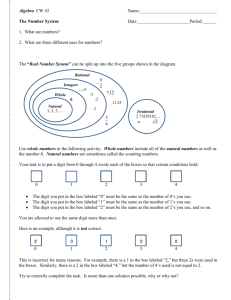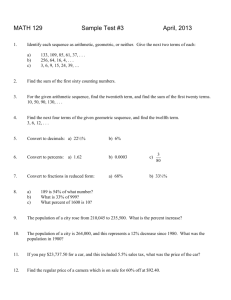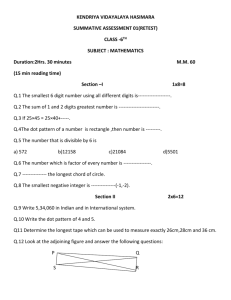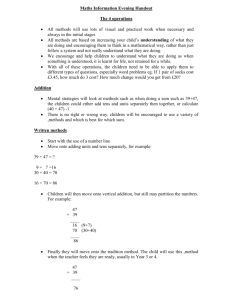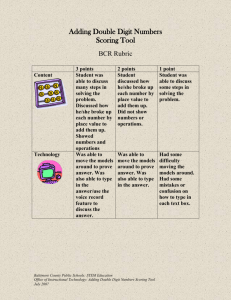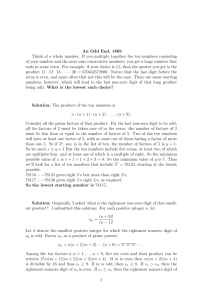2008 Programming Contest Problem Sets
advertisement
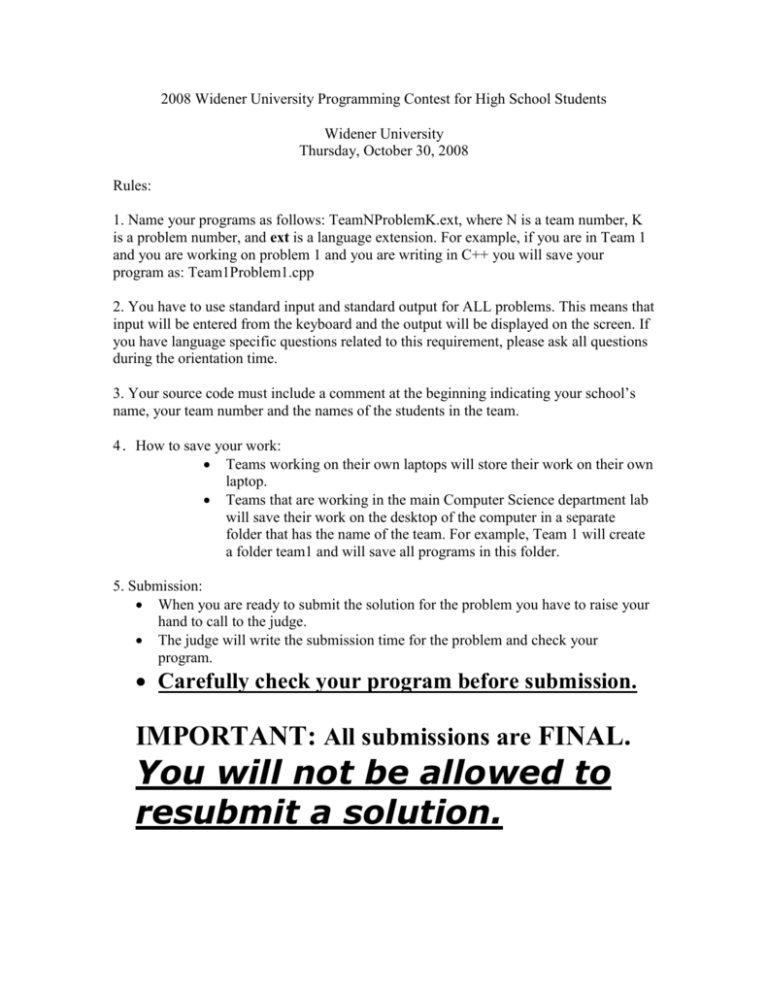
2008 Widener University Programming Contest for High School Students
Widener University
Thursday, October 30, 2008
Rules:
1. Name your programs as follows: TeamNProblemK.ext, where N is a team number, K
is a problem number, and ext is a language extension. For example, if you are in Team 1
and you are working on problem 1 and you are writing in C++ you will save your
program as: Team1Problem1.cpp
2. You have to use standard input and standard output for ALL problems. This means that
input will be entered from the keyboard and the output will be displayed on the screen. If
you have language specific questions related to this requirement, please ask all questions
during the orientation time.
3. Your source code must include a comment at the beginning indicating your school’s
name, your team number and the names of the students in the team.
4. How to save your work:
Teams working on their own laptops will store their work on their own
laptop.
Teams that are working in the main Computer Science department lab
will save their work on the desktop of the computer in a separate
folder that has the name of the team. For example, Team 1 will create
a folder team1 and will save all programs in this folder.
5. Submission:
When you are ready to submit the solution for the problem you have to raise your
hand to call to the judge.
The judge will write the submission time for the problem and check your
program.
Carefully check your program before submission.
IMPORTANT: All submissions are FINAL.
You will not be allowed to
resubmit a solution.
Problems
Problem 1:
Write a program that inputs a series of non-negative integers between 0 and 100. Each
such integer indicates a student’s grade. The first negative value will terminate the input.
The program outputs the letter equivalent for each numeric grade according to the
following table:
A: 100 - 90
B: 89 – 75
C: 74 – 65
D: 64 - 60
F: 59 – 0
You can assume that the input is a valid sequence of integers between 0 and 100. You can
assume that the input is not empty – there is at least one non-negative integer in the input
sequence before the negative number that terminates the input. You don’t need to check
the validity of the input.
Example 1:
Input: 63, 75, 100, 0, 74, 86, 98, 75, -9
Output: D, B, A, F, C, B, A, B
Example 2:
Input: 75, -8
Output: B
Example 3:
Input: 0, 0, 100, -9
Output: F, F, A
Example 4:
Input: 100, 78, 60, -9
Output: A, B, D
Example 5:
Input: 74, 0, -98
Output: C, F
Problem 2:
There is a treasure chest with 1 million dollars. The chest has a 6-digit combination lock
that opens under the following conditions: the first digit should be equal to the third digit,
the second digit should be even, and the sum of the fourth, fifth and sixth digits should be
divisible by 7. Write a program that reads one 6-digit positive integer and checks whether
the input number opens the chest or not. The output should be YES, if the chest opens,
and NO otherwise. You can assume that the input is a positive number between 100000
and 999999.
Example 1:
Input: 525734
Output: YES
Example 2:
Input: 525737
Output: NO
Explanation for the output:
The answer is NO, since the sum of fourth, fifth and sixth digits, which is 7+3+7=17, is
not divisible by 7.
Example 3:
Input: 425737
Output: NO
Explanation for the output:
The answer is NO, since first digit is not equal to the third digit, 4 is not equal 5, and also
the sum of fourth, fifth and sixth digits, which is 7+3+7=17, is not divisible by 7.
Example 4:
Input: 535034
Output: NO
Explanation for the output:
The answer is NO, since the second digit is odd, 3 is odd
Example 5:
Input: 505770
Output: YES
Example 6:
Input: 513707
Output: NO
Explanation for the output:
The answer is NO, since the second digit is odd, 1 is odd and also the first digit is not
equal to the third digit, 5 is not equal to 3.
Problem 3:
It is possible to calculate an approximate value of by using the following formula
= 4 – 4/3 + 4/5 – 4/7 + 4/9 – 4/11 + 4/13 – 4/15 +.....
Write a program that accepts one positive integer which indicates the number of terms
from the above formula to be calculated and outputs the corresponding value for the sum.
You can assume that the input is valid. Use whatever floating point format your language
provides by default for the output.
Example 1:
Input: 2
Output: 2.666667
Explanation for the output:
Since the input is 2, two first terms of the given sum are taken in account to calculate the
approximate value of . The result is 4 – 4/3 = 2.666667
Example 2:
Input: 3
Output: 3.466668
Explanation for the output:
Since the input is 3, three first terms of the given sum are taken in account to calculate
the approximate value of . The result is 4 – 4/3 + 4/5 = 3.466668
Example 3:
Input: 1
Output: 4.000000
Example 4:
Input: 5
Output: 3.339683
Explanation for the output:
Since the input is 5, five first terms of the given sum are taken in account to calculate the
approximate value of . The result is 4 – 4/3 + 4/5 – 4/7 + 4/9 = 3.339683
Example 5:
Input: 7
Output: 3.283738
Explanation for the output:
Since the input is 7, seven first terms of the given sum are taken in account to calculate
the approximate value of . The result is 4 – 4/3 + 4/5 – 4/7 + 4/9 – 4/11 + 4/13 =
3.283738
Problem 4:
A square array of numbers is said to be a "magic square" if all the rows, columns, and
diagonals add up to the same number. For example, here is a 3 × 3 magic square:
4 9 2
3 5 7
8 1 6
Each row, column, and diagonal of this square adds up to 15. This example shows the
normal magic square, since we used numbers from 1 to 9 to build the square.
Write a program which takes any 9 integers as inputs, prints out the 3 by 3 square which
they form, and then a YES or NO according to whether the square is a magic square or
not. You can also assume that input is valid. You can assume that the input is read by
rows: the first three input integers are the first row of the square, the second three input
integers are the second row of the square, and finally the last three inputs are the third
row of the square. Pay attention, in this program the input could be any 9 integers. Pay
attention, the program has to output the square. See examples below.
Example 2
Input: 4 9 2 3 5 7 8 1 6
Output:
492
357
816
YES
Example 2
Input: 5 -1 2 7 0 4 5 6 7
Output:
5 -1 2
7 04
5 67
NO
Example 3
Input: 5 5 5 5 5 5 5 5 5
Output:
555
555
555
YES
Example 4
Input: 1 5 9 6 7 2 8 3 4
Output:
159
672
834
NO
Explanation of the output: the sum of the numbers on the diagonals are 12 and 24 and it
is not equal to the sum of the numbers in the rows and columns, that is 15 in this example
Example 5
Input: 1 6 8 9 2 4 5 7 3
Output:
168
924
573
NO
Explanation of the output: the sum of the numbers on the main diagonal is 6 and it is not
equal to the sum of the numbers in the rows, columns, and secondary diagonal which is
15 in this example
Example 6
Input: 11 4 9 6 8 10 7 12 5
Output:
11 4 9
6 8 10
7 12 5
YES
Example 7
Input: -3 2 1 4 0 -4 -1 -2 3
Output:
-3 2 1
4 0 -4
-1 -2 3
YES
Problem 5:
Write a program that reads a sequence that consists of the following characters ONLY
without any spaces: ( ) { } [ ] followed by a *. We will call all these characters
“brackets”.
The * indicates the end of the input. You can assume that the maximal length of the input
is 30 characters not including *.
The program checks whether the input is a legal sequence of “brackets” and outputs YES
if it is, and outputs NO, otherwise. A legal sequence is a sequence that has a matching
closing “bracket” for each correspondent open “bracket” and whose brackets are properly
nested. See examples below.
Example 1:
Input: (( )) *
Output: yes
Example 2:
Input: ([ ])( ){} *
Output: YES
Example 3:
Input: ([ ] { } *
Output: NO
Example 4:
Input: ({[ ])} *
Output: NO
Explanation for the output: The brackets are not properly nested.
Example 5:
Input: ({)} *
Output: NO
Example 6:
Input: ([{( )[ ]}]){( )} *
Output: YES
Example 7:
Input: ( *
Output: NO
Example 8:
Input: [} *
Output: NO
